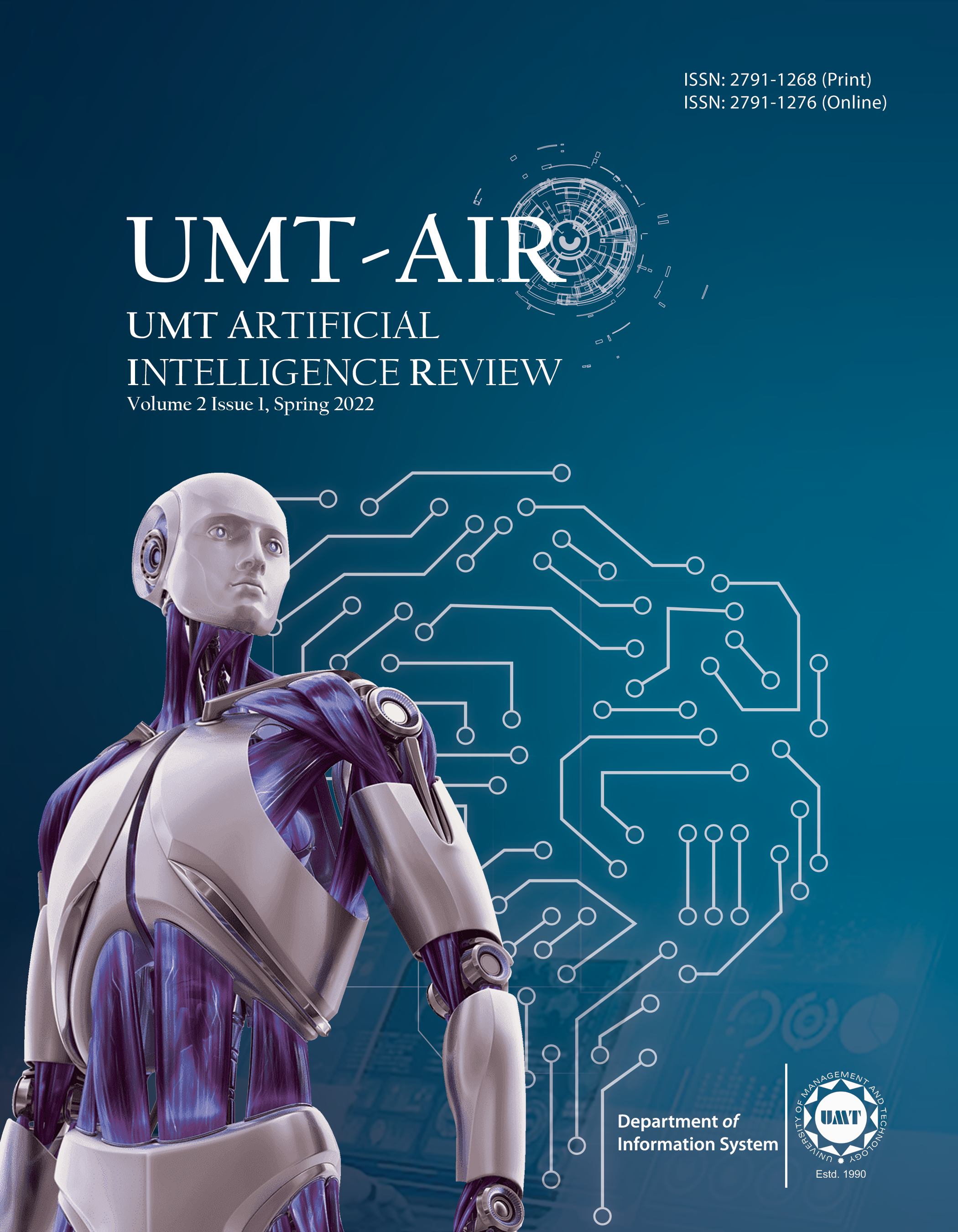Nuclei Spotting for Computational Pathology in Microscopic Images
Abstract
 Abstract Views: 69
Abstract Views: 69
Nuclei spotting has been given a paramount importance in diagnosing and monitoring many medical conditions. It also helps the pharmacists to develop and discover new formulas of drugs/remedy by observing the effects of medicines on the patients. Nuclei spotting becomes a challenging task due to the natural variation in the appearance as well as the variation of image capturing devices. Besides, variation in the lightening conditions also pose extra challenges in the process of detection and segmentation of nuclei. In the current study, we employed a modified U-Net (mU-Net), a deep learning-based approach, for nuclei detection and segmentation. The results showed the supremacy of the proposed method. Intersection over Union (IOU) of 0.78 was achieved on BBBC038v1 dataset.
Downloads
References
M. Z. Alom, C. Yakopcic, T. M. Taha, and V. K. Asari, “Microscopic nuclei classification, segmentation and detection with improved deep convolutional neural network(dcnn) approaches,” arXiv preprint, arXiv e1811.03447, 2018, doi:
https://doi.org/10.48550/arXiv.1811.03447
M. G. Rojo, V. Punys, J. Slodkowska, T. Schrader, C. Daniel, and B. Blobel, “Digital pathology in Europe: Coordinating patient care and research efforts,” Stud. Health Technol. Inform., vol. 150, pp. 997–1001, 2009, doi: https://doi.org/10.3233/978-1-60750-044-5-997
H. Irshad et al., “Crowdsourcing image annotation for nucleus detection and segmentation in computational pathology: evaluating experts, automated methods, and the crowd,” in Pac. Sympos. Biocomput., 2014, pp. 294-305. https://doi.org/10.1142/9789814644730_0029
Broad BioImages Benchmark Collection, “Kaggle 2018 data science bowl, 2019,” Broad BioImages Benchmark collection.
T.-Y. Lin, P. Goyal, R. Girshick, K. He, and P. Dollár, “Focal loss for dense object detection,” inProc. IEEE Int. Conf. Comput. Vision., 2017, pages 2980–2988.
D. Bhattacharjee and A. Paul, “A leukocyte detection technique in blood smear images using plant growth simulation algorithm,” in 31st AAAI Conf. Artifi. Inteell., 2017.
T.-Y. Lin, P. Goyal, R. Girshick, K. He, and P. Dollár, “Focal loss for dense object detection,” in Proc. IEEE Int. Conf. Comput. Vision., 2017, pages 2980–2988.
M. Khoshdeli and B. Parvin, “Feature-Based representation improves color decomposition and nuclear detection using a convolutional neural network,” in IEEE Transac. Biomed. Eng., vol. 65, no. 3, pp. 625-634, Mar. 2018, doi: https://doi.org/10.1109/TBME.2017.2711529
Y. Xie, F. Xing, X. Shi, X. Kong, H. Su, and L. Yang, “Efficient and robust cell detection: A structured regression approach,” Med. Image Anal., vol. 44, pp. 245–254, 2018, doi: https://doi.org/10.1016/j.media.2017.07.003
H. Chen, X. Qi, L. Yu, Q. Dou, J. Qin, and P.-A. Heng. Dcan: Deep contour-aware networks for object instance segmentation from histology images. Medical Image Analysis, 36:135–146, Feb. 2017, doi: https://doi.org/10.1016/j.media.2016.11.004
A. Tareef, Y. Song, H. Huang, Y. Wang, D. Feng, M. Chen, and W. Cai, “Optimizing the cervix cytological examination based on deep learning and dynamic shape modeling,” Neurocomputing, vol. 248, pp. 28–40, 2017, doi: https://doi.org/10.1016/j.neucom.2017.01.093
K. He, G. Gkioxari, P. Dollár, and R. Girshick, “Mask R-CNN. (2018),” arXiv. arXiv preprint arXiv:1703.06870.
Kaggle Combination, “Kaggle 2018 data science bowl competition,” Broad BioImages Benchmark collection.
Kaggle Combination, “Kaggle 2018 data science bowl competition, 2018,” Broad BioImages Benchmark collection. https://www.kaggle.com/competitions/data-science-bowl-2018[15] Broad Institute, “Kaggle 2018 data science bowl, 2019,” Broad BioImages Benchmark collection. https://bbbc.broadinstitute.org/BBBC038
O. Ronneberger, P. Fischer, and T. Brox, “U-net: Convolutional networks for biomedical image segmentation,” in Int. Conf. Med. Image Comput. Computer-Assisted Interv., Navab, N., Hornegger, J., Wells, W., and Frangi, A. Eds., Cham, Springer, 2015, pp. 234–241, doi: https://doi.org/10.1007/978-3-319-24574-4_28
D.-A. Clevert, T. Unterthiner, and S. Hochreiter, “Fast and accurate deep network learning by exponential linear units (elus),” arXiv preprint, arXiv:e1511.07289, 2015, doi: https://doi.org/10.48550/arXiv.1511.07289
ISBI, “ISBI challenge on cancer metastasis detection in lymph node,” ISBI. https://camelyon16.grand-challenge.org/Results/ (accessed Feb. 9, 2022).
Copyright (c) 2022 Abdul Basit Syed, Samabia Tehsin, Sumaira Kausar

This work is licensed under a Creative Commons Attribution 4.0 International License.
UMT-AIR follow an open-access publishing policy and full text of all published articles is available free, immediately upon publication of an issue. The journal’s contents are published and distributed under the terms of the Creative Commons Attribution 4.0 International (CC-BY 4.0) license. Thus, the work submitted to the journal implies that it is original, unpublished work of the authors (neither published previously nor accepted/under consideration for publication elsewhere). On acceptance of a manuscript for publication, a corresponding author on the behalf of all co-authors of the manuscript will sign and submit a completed the Copyright and Author Consent Form.







